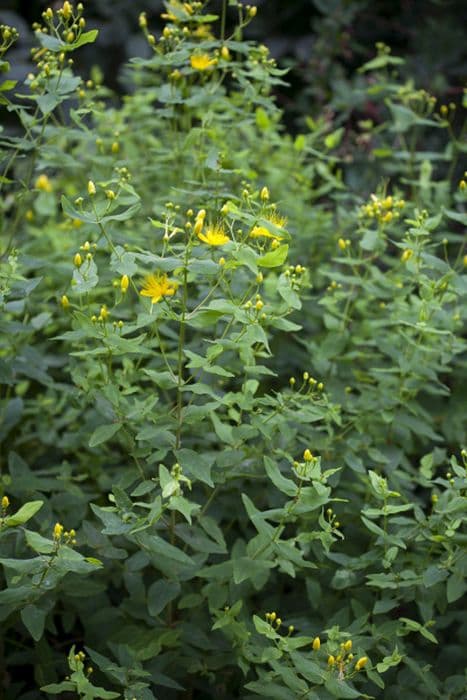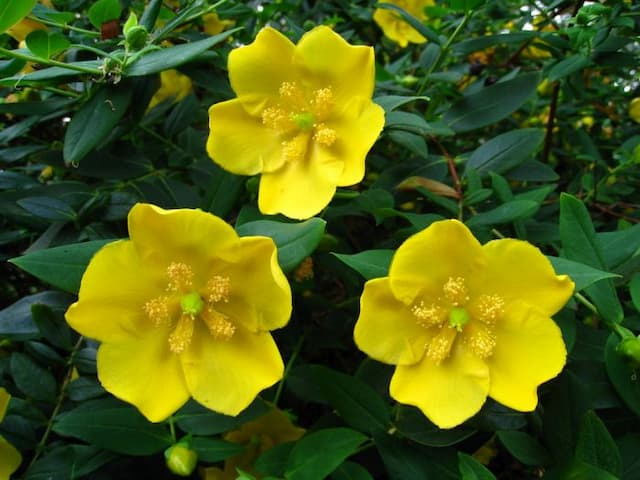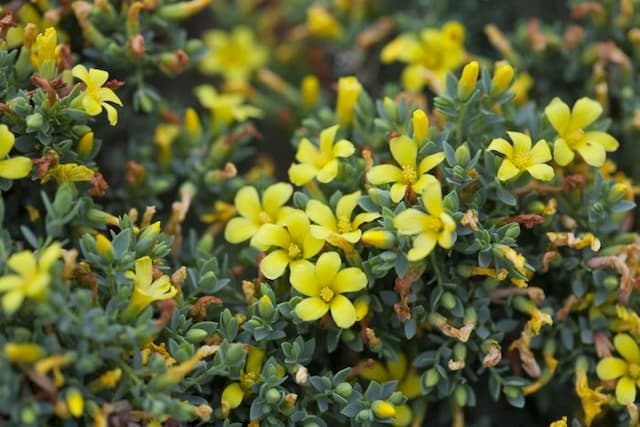Olympic St. John's Wort Hypericum olympicum f. minus

ABOUT
The plant known as Olympic St. John's Wort is a small, low-growing perennial shrub that showcases striking yellow flowers. These blooms have a profuse number of bright yellow petals, which are often adorned with delicate black dots along the margins. At the center of each flower, a burst of numerous, long stamens can be seen, which are typically a paler shade of yellow. The foliage of Olympic St. John's Wort consists of small, narrow leaves that exhibit a blue-green hue and are arranged in opposite pairs along the stems. This plant exudes a rustic charm with its dense, bushy appearance, and the little leaves provide a fine-textured backdrop for the radiant flowers. As the seasons change, some of them may bear red-colored, berry-like fruits that add further interest to the plant's appearance. It typically has a neat, compact habit, making it a suitable choice for rock gardens or as a ground-covering plant. The Olympic St. John's Wort's visual appeal is further enhanced by its ability to attract various pollinators, who are drawn to its bright flowers and the nectar they provide.
About this plant
 Names
NamesSynonyms
Olympic St. John's Wort, Dwarf St. John's Wort
Common names
Hypericum olympicum var. minus, Hypericum olympicum subsp. minus
 Toxicity
ToxicityTo humans
Hypericum, commonly known as St. John's Wort, can have toxic effects if ingested in large quantities. Although it is often used for medicinal purposes, particularly in the treatment of depression, consumption of St. John's Wort can lead to side effects such as dizziness, confusion, gastrointestinal symptoms, photosensitivity, and in severe cases, it can interact with various medications leading to potentially serious health consequences. It is important to use this plant only as directed and under professional guidance to avoid any adverse effects.
To pets
St. John's Wort, while beneficial to humans in controlled doses, can be toxic to pets if ingested. Symptoms of poisoning in pets may include lethargy, drooling, vomiting, diarrhea, and in severe cases, can lead to neurological symptoms like tremors. Photosensitivity can also occur, which means pets may suffer from skin irritation or burns if exposed to the sun after ingesting the plant. If you suspect your pet has consumed St. John's Wort, it is important to seek veterinary care immediately to mitigate any potentially harmful effects.
 Characteristics
CharacteristicsLife cycle
Perennials
Foliage type
Evergreen
Color of leaves
Green
Flower color
Yellow
Height
1 foot (30 cm)
Spread
1.5 feet (45 cm)
Plant type
Shrub
Hardiness zones
8
Native area
Turkey
Benefits
 General Benefits
General Benefits```html
- Ornamental Value: Hypericum olympicum f. minus, commonly known as Olympic St. John's Wort, has bright yellow flowers that add aesthetic appeal to gardens and landscapes.
- Drought Tolerance: This plant is highly adaptable to dry conditions, making it suitable for xeriscaping and water-conserving gardens.
- Low Maintenance: Olympic St. John's Wort typically requires minimal care once established, making it a convenient choice for gardeners with limited time.
- Wildlife Attraction: The flowers attract pollinators such as bees and butterflies, contributing to the local ecosystem's biodiversity.
- Ground Cover: Its dense growth habit can help to suppress weeds, reducing the need for chemical herbicides.
- Erosion Control: The plant's sturdy root system can help to stabilize soil on slopes and prevent the loss of topsoil due to water or wind erosion.
 Medical Properties
Medical Properties- Antidepressant: Contains hypericin, which is thought to have mood stabilizing and antidepressant effects.
- Anti-inflammatory: May reduce inflammation and soothe skin conditions when applied topically.
- Antibacterial: Exhibits antibacterial properties against various strains of bacteria.
- Antiviral: Has compounds that are effective against certain viruses, particularly when used in topical applications.
- Wound healing: Promotes healing of minor wounds and burns when used as an ointment or poultice.
- Anxiolytic: Contains compounds that may help to reduce anxiety symptoms.
- Antioxidant: Contains flavonoids and other antioxidant compounds that can protect cells from oxidative stress.
- Neuroprotective: May have protective effects on the nervous system, although this is still under study.
 Air-purifying Qualities
Air-purifying QualitiesThis plant is not specifically known for air purifying qualities.
 Other Uses
Other Uses- Dried Floral Arrangements: The attractive, long-lasting flowers of Hypericum olympicum are often used in dried floral arrangements to add a natural and rustic touch.
- Natural Dye: The plant’s flowers and sometimes the stems can be used to produce a natural dye for textiles, providing shades of yellow and gold.
- Garden Borders: Due to its compact growth habit, Hypericum olympicum is ideal for creating low, dense borders along garden pathways or beds.
- Erosion Control: The species can be used on slopes or banks to stabilize soil and prevent erosion due to its mat-forming growth.
- Ground Cover: It serves as an excellent ground cover in sunny areas due to its spreading nature and tolerance for poor soil.
- Bee and Pollinator Attraction: The flowers are a good source of nectar, attracting bees and other pollinating insects to the garden.
- Photographic Subject: With bright yellow flowers and striking green foliage, Hypericum olympicum is commonly photographed for its beauty and used in botanical art.
- Rock Gardens: The plant's ability to thrive in gravelly soil makes it a great addition to rock gardens where it provides a splash of color.
- Craft Projects: The seed pods and stems can be used in various craft projects, such as wreath making or as an accent in handmade paper.
- Education: Hypericum olympicum can be used to teach about medicinal plant history, excluding its use, to educate on traditional practices and the importance of biodiversity in local ecosystems.
Interesting Facts
 Feng Shui
Feng ShuiThe St. John's Wort is not used in Feng Shui practice.
 Zodiac Sign Compitability
Zodiac Sign CompitabilityThe St. John's Wort is not used in astrology practice.
 Plant Symbolism
Plant Symbolism- Protection: Hypericum, also known as St John's Wort, is often associated with warding off evil spirits and negative energies, reflecting an ancient belief that the plant has protective qualities.
- Healing: Traditionally, St John's Wort has been used for its medicinal properties, symbolizing physical and emotional healing.
- Strength: The hardy nature of the plant, able to thrive in various conditions, represents resilience and inner strength.
- Light and Happiness: St John's Wort blooms around St John's Day (June 24th) when days are long and filled with light, thus it is often linked to brightness, joy, and the dispelling of darkness.
- Banishment of Negative Thoughts: Its use in herbal medicine to treat depression is reflected in its symbolism as a plant that can drive away negative thoughts and usher in a positive mindset.
 Water
WaterThe Olympic St. John's Wort (Hypericum olympicum f. minus) prefers moderate watering. Ensure the soil is moist but not soaking wet by checking the top inch for dryness before adding water. Typically, watering once a week with about 16-32 ounces should suffice, but this can vary depending on temperature and humidity. During the growing season in spring and summer, they may need water more frequently, while in winter, watering can be reduced.
 Light
LightOlympic St. John's Wort thrives in full sun to partial shade. The ideal location would receive morning sun and some afternoon shade, or dappled light throughout the day to protect the plant from intense, midday sun.
 Temperature
TemperatureOlympic St. John's Wort can tolerate a temperature range between 50°F and 85°F. They are hardy in cooler conditions but should not be exposed to temperatures below freezing for prolonged periods. The ideal temperature for these plants is around 60°F to 75°F.
 Pruning
PruningPruning Olympic St. John's Wort promotes bushier growth and prevents legginess. Prune lightly in early spring to shape the plant and remove any dead or damaged branches. Pruning can be done again after flowering to maintain the desired size and shape.
 Cleaning
CleaningAs needed
 Soil
SoilOlympic St. John's Wort thrives best in well-draining, sandy or loamy soil with a slightly acidic to neutral pH of 6.0 to 7.0. A good soil mix can be made from equal parts sand, loam, and peat moss to ensure proper drainage and aeration.
 Repotting
RepottingOlympic St. John's Wort does not need frequent repotting; it can be repotted every 2 to 3 years or when it outgrows its current pot, ensuring room for root growth and soil refreshment.
 Humidity & Misting
Humidity & MistingOlympic St. John's Wort prefers moderate humidity levels but is quite adaptable and can tolerate the dry air of most indoor environments without needing special humidity adjustments.
 Suitable locations
Suitable locationsIndoor
Place in bright, indirect light and avoid overwatering.
Outdoor
Full sun to part shade; protect from excessive winter moisture.
Hardiness zone
5-9 USDA
 Life cycle
Life cycleHypericum olympicum f. minus, commonly known as Olympic St. John's Wort, begins its life cycle as a seed that germinates in spring when the soil temperature and moisture levels are appropriate. Emerging as a seedling, it soon develops a rosette of leaves at the base while its root system establishes itself in the soil. As the plant matures, it sends up flowering stems in early to mid-summer, bearing bright yellow flowers that are pollinated by insects, leading to seed production. After pollination, the flowers develop into capsules filled with numerous small seeds that are dispersed by wind, gravity, or possibly by animals. The plant then enters a period of dormancy in late fall and winter, with above-ground parts dying back while the root system remains alive. Each year, the plant can grow back from its perennial rootstock, repeating the cycle and gradually expanding its presence in the landscape.
 Propogation
PropogationPropogation time
Spring-Early Summer
Hypericum olympicum f. minus, commonly known as the Olympic St. John's Wort, is best propagated through seeds. The ideal time to sow seeds is in fall or early spring, allowing them to stratify naturally if sown outdoors which can enhance germination rates. To propagate, seeds should be scattered on the surface of a well-drained seed starting mix and gently pressed into the soil, but not buried, as they require light for germination. The soil should be kept moist but not waterlogged, and placed in a warm, bright area, avoiding direct sunlight. Germination can be slow, so patience is necessary, and once seedlings appear and reach a sufficient size, they can be transplanted into individual pots or directly into the garden.









